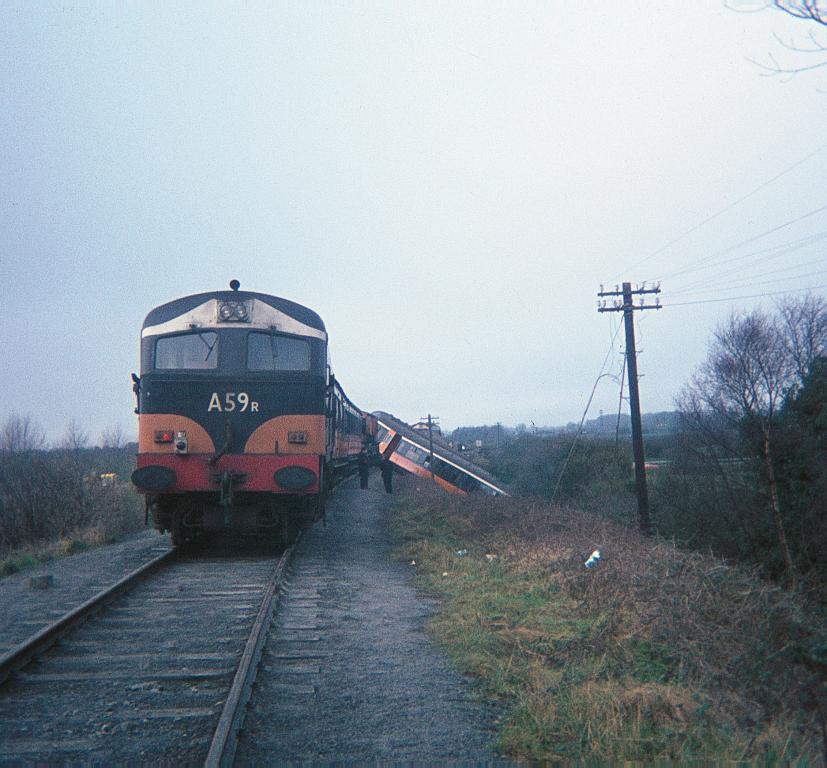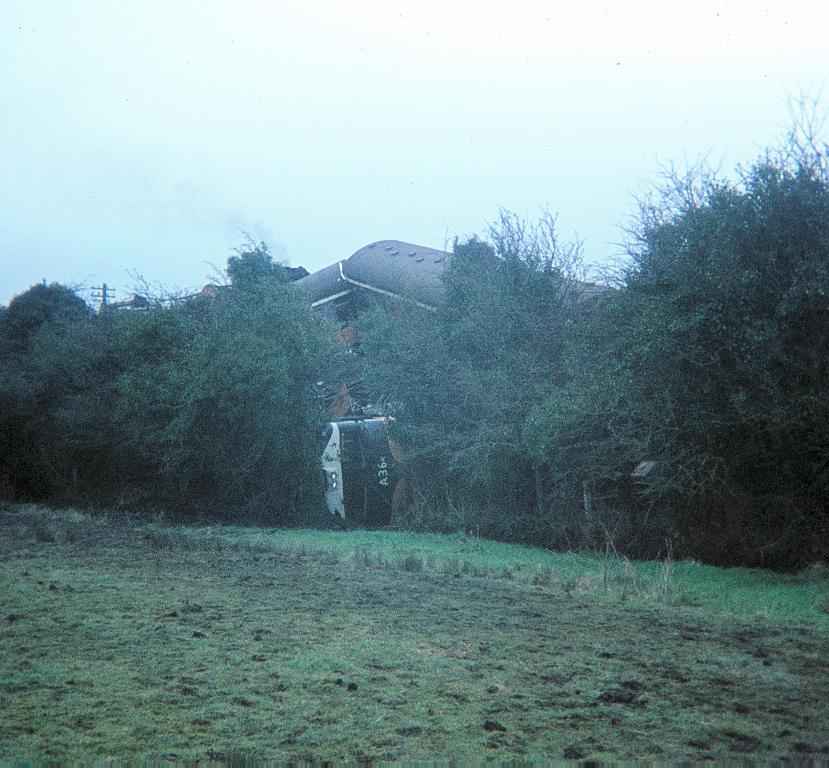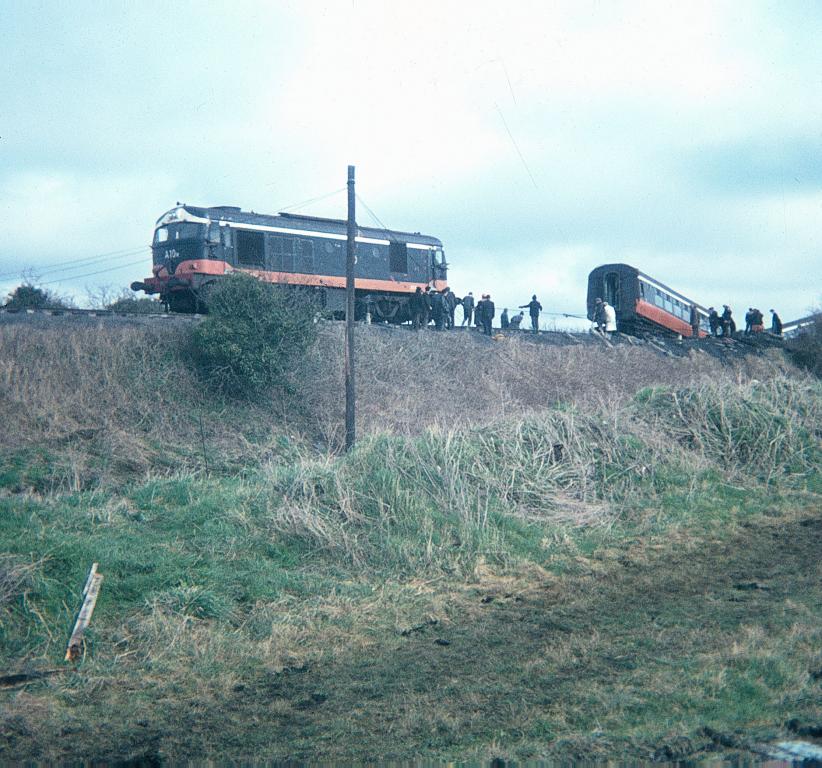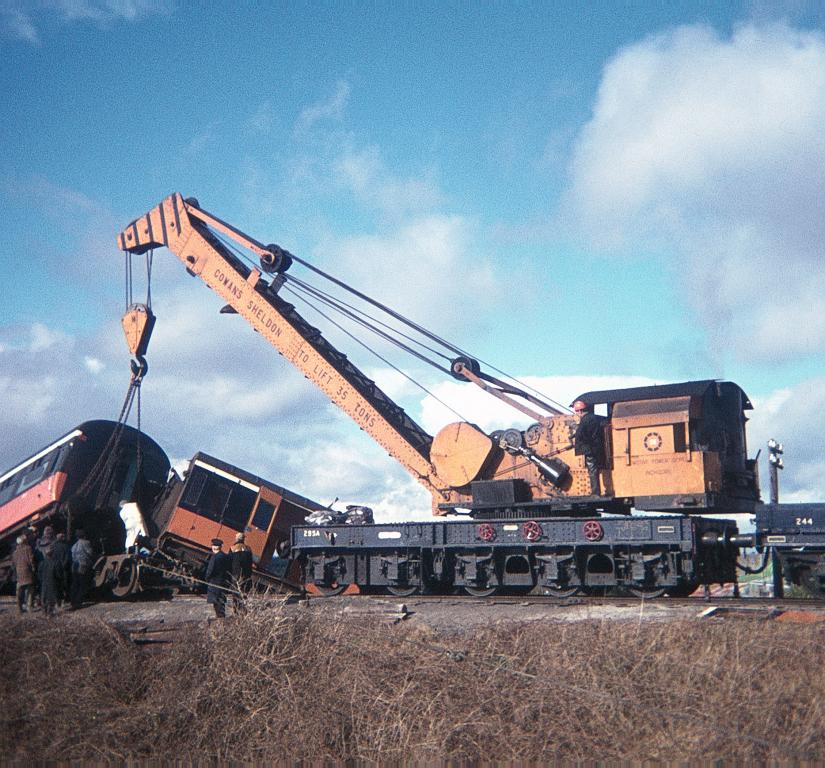-
Posts
1,036 -
Joined
-
Last visited
-
Days Won
5
Content Type
Profiles
Forums
Resource Library
Events
Gallery
Blogs
Store
Community Map
Posts posted by josefstadt
-
-
Fantastic work on the AR class. I'd agree with you that the white line looks a little bit too wide. The orange band along the side of the loco between the cab doors is more problematic. Barry Carse's excellent book 'Irish Metro-Vick Diesels' has a photo on the front cover showing A20R with the dipped orange band as described by Glenderg. However, inside the book there are photos of other members of the class, A39R and A51R, with the full width band as depicted on the model. Both these were rebuilt as GMs in 1969, while A20R was done the following year. I don't know if A20R originally had the full width band and this was later altered to the dipped version or whether it received the dipped version at re-building, but would suggest possibly the latter.
-
Seems to still be a mixture of 4-car ICRs, 3-car ICRs and 4-car 29000s at the moment.
-
The large numbers on the cab fronts and sides are a step in the right direction alright. However, the full 12-digit number (the European Vehicle Number - EVN) is only needed once on each side, not twice as IÉ have done. Putting the 3-digit number in black on the yellow panel on the cab front, in a larger font, would have improved readability even more. Also, having the 3-digit number, the full 12-digit EVN and the logo on the cab side at bot ends makes the whole appearance look cluttered. It would have looked far better if the 12-digit EVN had been positioned under the catwalk in the centre of the locomotive, with only the 3-digit number, again in a larger font, under the cab side windows at each end.
-
Stunning workmanship!
-
Hope you had a great day!
-
Belated congratulations!
-
-
If they were square, you wouldn't need a handbrake.

-
This French video pays tribute to an important 'new' geographical navigation device:
-
From the IÉ website:
Enniscorthy Station will be 150 years old on Saturday 16th November and to celebrate Iarnród Éireann is hosting a family fun day at Enniscorthy Station from 12 noon. Local musicians and face painters will be on hand to entertain young and old alike.
To mark this important occasion Iarnród Éireann will be offering special fares from €1.50 each way between Enniscorthy & Dublin for Sunday 17th November. These fares are available online and will sell out fast so Book Above Now.
-
It's great when a plan starts to come together! All the hard work planning is paying off - congratulations. Looking forward to seeing more updates as work progresses.
-
Dick Fearn
in News
And the trains will be less frequent and shorter!
-
Dick Fearn
in News
Must have done something right.Stephen
Or maybe they don't know why he is 'much-maligned' over here!
-
Looks fantastic Kieran.
-
Today is the 120th anniversary of the birth of the noted industrial designer Raymond Loewy (November 5, 1893 – July 14, 1986). Born in France to a Jewish family, he spent most of his professional career in the United States where he chieved fame for the magnitude of his design efforts across a variety of industries.
Among Loewy's most iconic designs were the logos of Shell, Exxon, TWA and BP. He was also responsible for the Greyhound Scenicruiser bus, Coca-Cola vending machines, the Lucky Strike cigarette package, Coldspot refrigerators, the Studebaker Avanti and Champion, and the Air Force One livery.
In the railway field he designed the GG1 (http://www.railpictures.net/viewphoto.php?id=452363&nseq=5) and S-1 (http://en.wikipedia.org/wiki/File:PRR_S1.jpg) locomotives for the Pennsylvania Railroad.
-
Excellent footage Nelson. I certainly did enjoy it. The sound effects of the 80 accelerating away from the signal stop are so much better than those from the C4Ks!
And, of course, thanks to 33lima for posting the details of how he built those superb models. A fantastic thread.
-
The one thing that surprises me is that in 1974 they still felt it necessary, in the Airport Coach ad, to include'(Kingsbridge)' after 'Heuston Station'. After all it was eight years or thereabouts since the stations had been renamed.
-
Thanks for all the kind comments lads.
-
The word on the street (or should be the tracks) is that the test was for a new livery for the 29000s.
-
Thanks guys. I have to credit the IRRS Journal No. 64 (June 1974) for refreshing my memories on certain points in relation to both the Roscommon and Longford derailments. Also the Railway Safety Commission for details of injuries and the numbers on the train in the Longford incident which were sourced in its report 'Railway Bridges in Ireland & Bridge Strike Trends' February 2009.
-
Great stuff, Josefstadt! May I ask where you got the photos from?
I took them myself. In those days before the invention of the 'Health & Safety' culture one could wander almost freely about sites like this. If you got hurt, you got hurt and it was probably your own fault. The only proviso was that you didn't interfere with the work or distract the workmen. If I remember there were quite a few interested members of the public wandering around the site.
I was lucky that this derailment, and the one at Roscommon, happened when they did. In March 1974 I started working fulltime with CIÉ and, as that involved Saturday working, I wouldn't have been able to visit the sites so easily.
-
As mentioned previously, in the Roscommon train crash thread, February 1974 was not a good month for CIÉ with two serious derailments - the Roscommon one on the 16th of the month and a potentially more serious one at Longford on the 27th. Whereas the Roscommon crash featured a goods train, the one on the outskirts of Longford town involved a passenger train, the 07:45 from Sligo to Dublin.
During the early hours of the morning the bridge carrying the railway across what is now the N63 road was struck by a large container loaded on a lorry. The lorry driver reported the incident to the Gardaí who, in turn, notified CIÉ. However, due to a mix up the wrong bridge was examined by permanent way staff and, as no damage was found, the all clear was given. The bridge and track were subsequently found to be some 13 inches out of alignment.
The train consisted of locomotive A36R with 3106 (4-w Heating/Luggage Van), 1907 (Bk/Std), 1513 (Std), 1508 (Std), 2416 (Cafeteria), 2174(Composite) and 3161 (‘Dutch’ Van). The train was carrying 24 passengers and 3 crew. The locomotive derailed to the left as it crossed the bridge and ended up on its side at the foot of the embankment. The bodywork of 3106 was completely destroyed, while 1907 was severely damaged. The remainder of the train stayed upright, with all vehicles except 2174 and 3161 being derailed. Fortunately there were no major injuries largely due to there being no passengers in the two carriages that went down the embankment. Only the driver was removed to hospital, for precautionary reasons. One passenger received medical attention at Longford station but was fit enough to continue their journey to Dublin.
Recovery work involved re-railing 1508 and 2416 which, along with 2174 and 3161, were brought to Dromod. 1513 was lifted by the Inchicore and Limerick steam cranes and brought to Longford, as was the chassis of 3106. Following the removal of the carriages and vans, the embankment was repaired and the line reopened on the evening of 4 March. A36R, which had come to rest in a very awkward position, was not recovered until the weekend of 4 / 5 May, by which time a large amount of the locomotive’s brass and copper had been removed by persons from a local ‘caravan park’!
Until the evening of 4 March, train services operated Dublin-Longford and Dromod-Sligo, with bus transfers Longford-Dromod. 232 is running round its train in Longford after arriving with the morning train from Dublin.
A59R brought the Inchicore steam crane to the Dublin side of the derailment site. The support coaches for the crane (sorry don’t have a better pic of them) were of GS&WR origin. The coach seen at right angles to the line is 1907.
Work in progress on recovering Cravens Standard 1508. The steel hawser is attached to the carriage’s draw-hook at this end and to the one on A10R at the other end. Temporary rails were placed under the wheels of 1508 and the locomotive then dragged the carriage up the slope and back on to the running line (I presume that a risk analysis of the procedure was carried out!!!).
A10R ready to drag 1508 up the embankment. The line of temporary rails can just be seen between the rear of the loco and the man in the white coat. The trackwork and embankment where A10R is standing has already been repaired at this stage to facilitate recovery operations. The smoke rising above 1508 is from the Inchicore steam crane.
A36R lies on its side at the foot of the embankment. Above it are 1907 and 1513 and the remains of 3106.
A general view of the site from the northern side of the line. From the left are: one of the Inchicore support coaches, the Inchicore steam crane, 1907, 1513 and 1508, with A36R at the foot of the embankment.
A10R dragging 1508 up the embankment. The hawser connecting the locomotive to the carriage can be clearly seen. The staff controlling the operation are anxiously watching the wheels of 1508 to ensure they remain on the temporary rails.
The Inchicore steam crane preparing to lift one end of 1513 so that it can be separated from 1907.
Hope you enjoy the photos.
-
Transport Research Associates produced 'GSWR Carriage Diagrams' in 1975. This covers all the GS&WR stock still in existance in 1924 immediately before the the amalgamation which resulted in the formation of the GSR. The volume includes not only coaching stock vehicles (carriages, restaurant cars, luggage and brake vans) but also other vehicles which, because they were vacuum braked, could run in passenger trains (horse boxes, carriage trucks, fish vans etc). A lot of these vehicles lasted into the 1960s and some even were not withdrawan until the 1970s.
Each class of vehicle has a page devoted to it. Included are a drawing of one side and one end of the vehicle, as well as a plan view of the interior. There is also a table of dimensions and seating. Also included are details of build and withdrawal dates for each vehicle. - most useful for deciding which vehicles would be appropriate for a particular era.
I'd say this would be hard to find now but the IRRS would most probably have one which could be referenced.
-
Why not A class? If I remember correctly A was for locomotives over 1,000 hp (or was it 1,200 hp?). So A71 - A88. H class would have been for something less powerful than a Deutz. A horse and cart maybe?
.png.c363cdf5c3fb7955cd92a55eb6dbbae0.png)











Some ideas for IÉ / RPA / NTA
in News
Posted
Came across this interesting video about to London Underground's plans for the future:
Food for thought for our transport providers and the Government / local authorities.